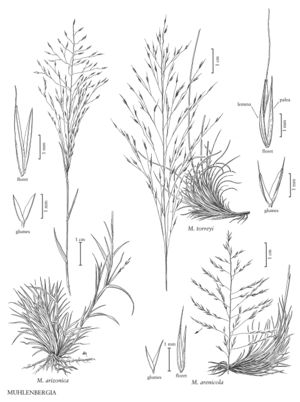Difference between revisions of "Muhlenbergia arenicola"
FNA>Volume Importer |
imported>Volume Importer |
||
| (8 intermediate revisions by 2 users not shown) | |||
| Line 17: | Line 17: | ||
-->{{Treatment/Body | -->{{Treatment/Body | ||
|distribution=Kans.;Okla.;Ariz.;Colo.;N.Mex.;Tex. | |distribution=Kans.;Okla.;Ariz.;Colo.;N.Mex.;Tex. | ||
| − | |discussion=<p>Muhlenbergia arenicola grows on sandy mesas, limestone benches, and in valleys and open desert grasslands, at elevations of 600-2135 m. Its range extends from the southwestern United States to central Mexico. It also grows, as a disjunct, in northwestern Argentina.</p> | + | |discussion=<p><i>Muhlenbergia arenicola</i> grows on sandy mesas, limestone benches, and in valleys and open desert grasslands, at elevations of 600-2135 m. Its range extends from the southwestern United States to central Mexico. It also grows, as a disjunct, in northwestern Argentina.</p> |
|tables= | |tables= | ||
|references= | |references= | ||
| Line 26: | Line 26: | ||
-->{{#Taxon: | -->{{#Taxon: | ||
name=Muhlenbergia arenicola | name=Muhlenbergia arenicola | ||
| − | |||
|authority=Buckley | |authority=Buckley | ||
|rank=species | |rank=species | ||
| Line 33: | Line 32: | ||
|basionyms= | |basionyms= | ||
|family=Poaceae | |family=Poaceae | ||
| + | |illustrator=Linda A. Vorobik;Annaliese Miller | ||
| + | |illustration copyright=Utah State University | ||
|distribution=Kans.;Okla.;Ariz.;Colo.;N.Mex.;Tex. | |distribution=Kans.;Okla.;Ariz.;Colo.;N.Mex.;Tex. | ||
|reference=None | |reference=None | ||
| Line 38: | Line 39: | ||
|publication year= | |publication year= | ||
|special status= | |special status= | ||
| − | |source xml=https:// | + | |source xml=https://bitbucket.org/aafc-mbb/fna-data-curation/src/200273ad09963decb8fc72550212de541d86569d/coarse_grained_fna_xml/V25/V25_743.xml |
|subfamily=Poaceae subfam. Chloridoideae | |subfamily=Poaceae subfam. Chloridoideae | ||
|tribe=Poaceae tribe Cynodonteae | |tribe=Poaceae tribe Cynodonteae | ||
Latest revision as of 18:58, 11 May 2021
Plants perennial; cespitose, not rhizomatous. Culms (15)20-60 (70) cm, somewhat decumbent, 1 or more nodes exposed; internodes hispidulous below the nodes. Leaves somewhat basally concentrated, most blades not reaching more than (1/4)1/2 of the plant height; sheaths usually a little shorter than the internodes, not keeled, scabridulous, margins hyaline, basal sheaths rounded, not becoming spirally coiled when old; ligules 2-9 mm, hyaline, acute, lacerate, often with lateral lobes; blades 4-10(16) cm long, 1-2.2 mm wide, not arcuate, flat, folded, or involute, scabrous, often glaucous, midveins and margins not thickened, green. Panicles 12-30 cm long, 5-20 cm wide, diffuse; primary branches 1-10 cm, diverging 30-80° from the rachises, naked basally; pedicels 1-4(6) mm. Spikelets 2.5-4.2 mm. Glumes equal, 1.4-2.5 mm, 1-veined, apices scabridulous, acute to acuminate, minutely erose, unawned or awned, awns to 1 mm; lemmas 2.5-4.2 mm, narrowly elliptic, usually purplish, scabrous distally, appressed-pubescent on the lower 1/2 - 3/4 of the margins and midveins, apices acuminate, awned, awns 0.5-4.2 mm; paleas 2.5-3.5 mm, narrowly elliptic, intercostal region sparsely pubescent, apices acuminate, with 2 short (0.1-0.2 mm) awns; anthers 1.5-2.1 mm, greenish. Caryopses 1.9-2.3 mm, fusiform, brownish. 2n = 80, 82.
Distribution
Kans., Okla., Ariz., Colo., N.Mex., Tex.
Discussion
Muhlenbergia arenicola grows on sandy mesas, limestone benches, and in valleys and open desert grasslands, at elevations of 600-2135 m. Its range extends from the southwestern United States to central Mexico. It also grows, as a disjunct, in northwestern Argentina.
Selected References
None.
